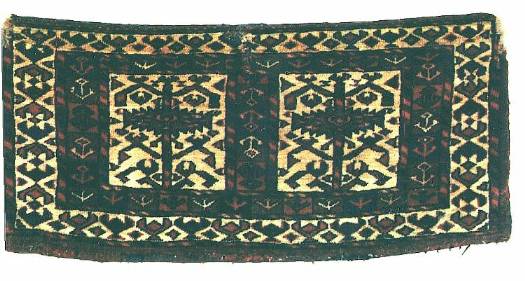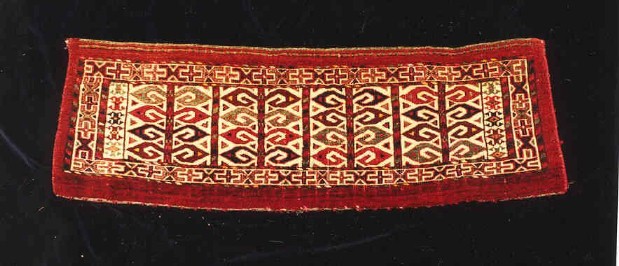| jpweiler@worldnet.att.net Steve, I have read numerous times that
border motifs can be illustrative in determining origin. In this
comparison, it appears to me that in fact the "evolution" of this piece is
the other way around. Both weavings have the same border. The mafrash has
a "degenerate" (or, as this salon would describe it, "evolved") version of
the border in the trapping. If the trapping field design evolved from the
mafrash, how could the mafrash have a more evolved border while the field
has a less evolved design? Now, if you add this example to the other
examples and replies to this topic, it becomes clear that the direct-line
evolutionary theory is in fact not clear at all. It seems more likely that
there is a constant cross-fertilization as opposed to a linear
progression. I am not saying that the original theory is not valid, but I
have been struggling to accomodate the theory with my observations. There
is more of a diffusion rather than a one way influence of design motifs. I
think it was either Beck or Housego who remarked upon the facility with
which tribal weavers would incorporate disparate designs into their
weavings, even having only briefly seen something of interest to them.
Granted, a weaver would have had to see a design to incorporate it into
her weaving ( aside from the "universal" designs incidental to the
construction of the weavings), but even migratory nomads had wide ranging
contact with a tremendous variety of design influences. Opie opines that
the Lur were quite isolated and, therefore their design pool is most
"pure" and was spread out among their neighbors, but the mere fact that
their neighbors got hold of and appropriated Lur designs into their own
weavings argues for an interaction that must have gone both ways. The
complex universe of designs and widespread dissemination seems more like
the language of chemical interactions than the language of speech. Patrick
Weiler |
 Another thing that's
interesting is to compare the "trees" in it with the "ram's horn tree" in
the piece shown in the other thread, which I've put here as well in order
to make the comparison easier.
Another thing that's
interesting is to compare the "trees" in it with the "ram's horn tree" in
the piece shown in the other thread, which I've put here as well in order
to make the comparison easier.  It's easy to visualize "tidying up" the "trees" in the mafrash
and ending up with the motifs in the trapping. Isn't this, more or less,
the way languages evolve? Steve Price
It's easy to visualize "tidying up" the "trees" in the mafrash
and ending up with the motifs in the trapping. Isn't this, more or less,
the way languages evolve? Steve Price